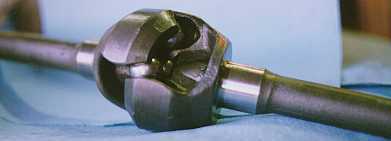

Spicer 25 Front Axle Knuckles

In the fall of 1997, I was bouncing down some pretty rocky roads in the
Four Peaks area. We had a good ride, but when we got back to town, I
found I couldn't turn very sharp. The steering would actually catch, and
refuse to turn any farther. I somehow managed to make it through 25 miles of
city traffic to home.
When I pulled the left front hub and wheel, I found the axle joint had
come apart. This joint is not the Spicer Cardon cross. Nor is it the
Rzeppa joint with the six balls in the ring cage either. This joint is
not in the service manual.
 As you can see in the
picture, this joint has a cup on each shaft that holds five balls
between the two shafts. Four are on the outside in contact with the cups
and the fifth is pegged in the center to hold the others in place. The
cups are shaped so the four balls are in contact with both cups at all
times. Rotation of one axle shaft tranfers force through the balls to
the other axle shaft. The shafts are held in place by the housing,
and there is no connection between the two shafts except the balls.
As you can see in the
picture, this joint has a cup on each shaft that holds five balls
between the two shafts. Four are on the outside in contact with the cups
and the fifth is pegged in the center to hold the others in place. The
cups are shaped so the four balls are in contact with both cups at all
times. Rotation of one axle shaft tranfers force through the balls to
the other axle shaft. The shafts are held in place by the housing,
and there is no connection between the two shafts except the balls.
On my axle, the edge of one of the cups was chipped, which allowed the balls to fall
out. The balls were getting jammed between the housing and the cup,
which was preventing the free articulation of the joint.
After calling around, I discovered this joint was made by Bendix. This type
of joint was only used in the early years, and I'm not sure if it was
used in all the Willys. I could not find any axles to replace my damaged
one. I drove for a few months with the damaged axle. It only dropped the
balls when turning to the maximum. After it dropped the balls again, I
removed the axle and drove without it. Of course, I couldn't use the
front axle drive, so no four wheeling. I eventually repaced the axle with a
Cardon cross type axle. I now have a Spicer left axle and a Bendix
right axle.

Rzeppa drawing from the manual

 As you can see in the
picture, this joint has a cup on each shaft that holds five balls
between the two shafts. Four are on the outside in contact with the cups
and the fifth is pegged in the center to hold the others in place. The
cups are shaped so the four balls are in contact with both cups at all
times. Rotation of one axle shaft tranfers force through the balls to
the other axle shaft. The shafts are held in place by the housing,
and there is no connection between the two shafts except the balls.
As you can see in the
picture, this joint has a cup on each shaft that holds five balls
between the two shafts. Four are on the outside in contact with the cups
and the fifth is pegged in the center to hold the others in place. The
cups are shaped so the four balls are in contact with both cups at all
times. Rotation of one axle shaft tranfers force through the balls to
the other axle shaft. The shafts are held in place by the housing,
and there is no connection between the two shafts except the balls.




